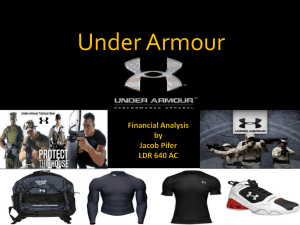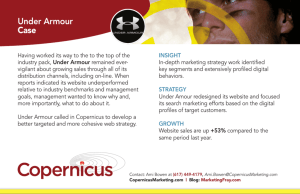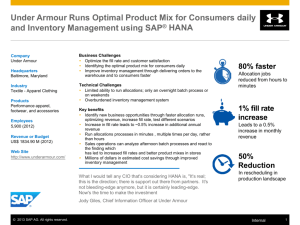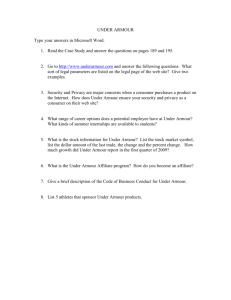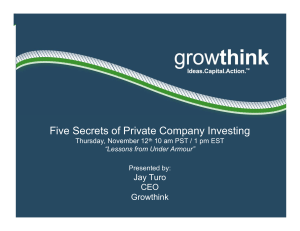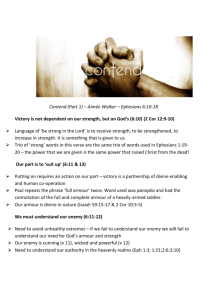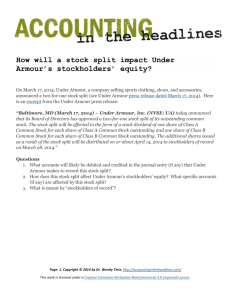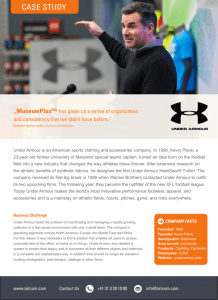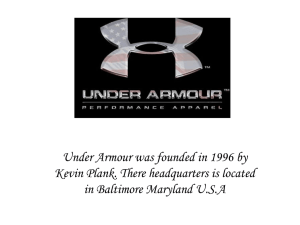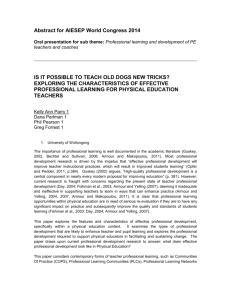Under Armour - Jacob Pifer
advertisement
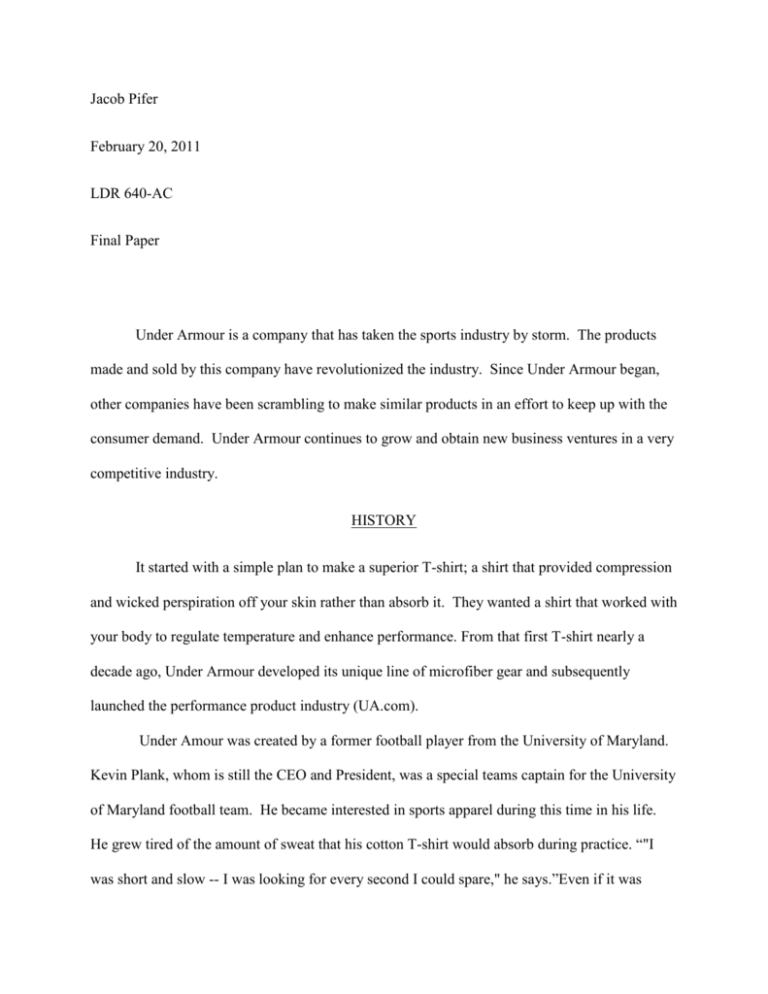
Jacob Pifer February 20, 2011 LDR 640-AC Final Paper Under Armour is a company that has taken the sports industry by storm. The products made and sold by this company have revolutionized the industry. Since Under Armour began, other companies have been scrambling to make similar products in an effort to keep up with the consumer demand. Under Armour continues to grow and obtain new business ventures in a very competitive industry. HISTORY It started with a simple plan to make a superior T-shirt; a shirt that provided compression and wicked perspiration off your skin rather than absorb it. They wanted a shirt that worked with your body to regulate temperature and enhance performance. From that first T-shirt nearly a decade ago, Under Armour developed its unique line of microfiber gear and subsequently launched the performance product industry (UA.com). Under Amour was created by a former football player from the University of Maryland. Kevin Plank, whom is still the CEO and President, was a special teams captain for the University of Maryland football team. He became interested in sports apparel during this time in his life. He grew tired of the amount of sweat that his cotton T-shirt would absorb during practice. “"I was short and slow -- I was looking for every second I could spare," he says.”Even if it was raining outside, [the sweat-soaked cottons] gave me that slowed-down lethargic feeling."” (SI.com, 1.) Plank began trying out different fabrics in an attempt to find an alternative to the cotton tshirt. He browsed several synthetic types of material and found some he liked. Plank invested $500 of his own money creating seven prototypes of his new invention. He decided on the one he liked the best, and approached his teammates to test them out. Several of them were very hesitant at first, but he told them it was for a job he had, and he wanted their advice. "It was all about making yourself bigger than you were. My first goal was getting athletes to believe in the fact that they needed an alternative to a basic cotton T-shirt. The way you do that is with a great product, but you also do it with influencers." (SI.com, 2) Several of these players enjoyed their new shirts. So much so they took them along when they entered the NFL. Plank began receiving phone calls from other professional and collegiate athletes, asking to try out these new shirts. Planks big break came when he landed a contract with Georgia Tech. The equipment manager at Georgia Tech, who was familiar with the shirts, contacted Plank and requested 350 shirts. Plank could only afford to send 60 of the shirts because that was all he had at the time. This deal with Georgia Tech opened the gates for a contract with North Carolina State. Several other Division I Colleges came calling, and the business was well on its way. Plank first broke into the NFL market after a Florida State football game. The equipment manager for the Atlanta Falcons, whom was a Florida State Alumnus, entered the locker room after the game and saw all the players wearing Under Armour gear (SI.com). "I'm sitting in grandma's basement in Georgetown, and the phone rings," Plank says. "The guy says, 'I'm the head equipment manager for the Atlanta Falcons and we want to buy your shirts.' Then the Falcons played the Giants. There, the equipment guy for the Falcons was a mentor to the equipment guy at the Giants and he liked our stuff." (SI.com, 2) After nearly a decade of Marketing and Networking, Under Armour has become a very profitable company and continues to grow. They are still developing new products and testing them out for various markets. COMPANY OVERVIEW: Kevin Plank is still the CEO and President of the company. They have offices all over the world to include, Toronto, Japan, China, and Amsterdam. They also have an office in Denver Colorado, with their headquarters in Baltimore Maryland. They employ over 2,000 workers throughout their company. Their Board of Directors is as follows: Plank, Kevin Chairman of the Board, President, Chief Executive Officer Dickerson, Brad Chief Financial Officer Marino, Wayne Chief Operating Officer Plank, J. Scott Executive Vice President - Business Development Fulks, Kip Executive Vice President - Product Dowley, Mark Executive Vice President - Global Brand and President - International McCarthy, Eugene Senior Vice President - Footwear Stafford, Henry Senior Vice President - Apparel Rogers, John Vice President, General Manager - Global E-Commerce Sawall, Daniel Vice President - Retail Krongard, A. Lead Independent Director Adams, Byron Director Coltharp, Douglas Director McDermott, William Director Sanders, Harvey Director Sippel, Thomas Director Deering, Anthony Director (Reuters.com) COMPETITION: Under Amour’s largest competitor is NIKE. Nike is a Giant in the sports apparel world. They are a very tough company to compete with. Other companies considered to be competitors are Adidas, and Columbia Sportswear. Both of these companies have a very small share of the market. In the case of Columbia, they concentrate mostly on cold weather apparel, reducing their market share even further. One of the markets that Under Armour has been able to penetrate is that of Military and Law Enforcement. Performance wear for these professions have mostly relied on cotton based clothing for under their uniforms. Most Law Enforcement uniforms are made of polyester and are very hot, uncomfortable, and do not breathe well. 5.11 Tactical is a company that has introduced shirts, pants, and other products for these professions. They have been very successful at catching the eyes of the consumers. If Under Armour continues to promote to this market, they could expand their lines even further. Although many do not consider 5.11 tactical to be a competitor, I am using them as such for this assignment. FINANCIALS: INCOME STATEMENT: Horizontal Analysis 2009 2008 2007 2009 2008 2007 Revenues $856,411 $725,244 $606,561 118% 119% 100% Cost of goods sold $443,386 $370,296 $301,217 119% 123% 100% Gross Profit $413,025 $354,948 $305,044 116% 116% 100% Selling Expense $327,752 $278,023 218,779 118% 127% 100% Income Operations $85,273 $76,925 $86,265 111% 89% 100% Interest inc (exp) ($2,344) $(850) $749 -275% -113% 100% Other Inc (Exp) ($511) ($6,175) $2029 1235% -304% 100% Income before tax $82,418 $69,900 $89,043 118% 78% 100% Taxes $35,633 $31,671 $36,485 Net Income $46,785 $38,229 $52,558 122% 72% 100% By looking at the Income Statement we can see an increase in almost all areas between the years. Even though the net income dropped from 2007 to 2008, it still showed an improvement in 2009. BALANCE SHEET: Assets 2009 2008 2007 Current Assets Cash and cash equivalents $187,297 $102,042 $40,588 Accounts Receivables $79,356 $81,302 $93,515 Inventories $148,488 $182,232 $166,082 Prepaid expenses and other Current Assets $19,989 $18,023 $11,642 Deferred income taxes $12,870 $12,824 $10,418 $448,000 $396,423 $322,245 Property and Equipment $72,926 $73,548 $52,332 Other long term assets $10,754 $8,897 $7,863 Deferred income taxes $13,908 $8,687 $8,173 $545,588 $487,555 $390,613 2009 2008 2007 Revolving Credit ---- $25,000 --- Accounts Payable $68,710 $72,435 $55,012 Accrued Expenses $40,885 $25,905 $36,111 Current Maturities $9275 $7431 $4,576 Total Current Assets Total Assets Current Liabilities Other Current Liabilities $1292 $2337 --- $120,162 $133,110 $95,699 Long Term Debt $10,948 $13,061 $9,298 Capital Lease Obligations ---- $97 $458 Other Long Term Liabilities $14,481 $10,190 $4,673 Total Liabilities $145,591 $156,458 $110,128 Total Stockholder’s Equity $399,997 $331,097 $280,485 Total Liabilities and Equity $545,588 $487,555 $390,613 Total Current Liabilities FINANCIAL RATIOS Industry Average: LIQUIDITY Current Ratio: 3.7x 3.5x Quick Ratio: 2.2x 1.1x ASSET MANAGEMENT: Days Sales Outstanding: 34.2 43 Total Asset Turnover 1.66x 1.7x DEBT MANAGEMENT: Debt Ratio: 27% TIE Ratio: 36.1 PROFITIBILITY: Profit Margin: 5.4% ROA: 9% ROE: 12.8% Book Value per Share $7.96 Unfortunately I was unable to find much of the industry average for these ratios. I know the information is out there, but in all my efforts I was unsuccessful in finding a numeric value to these ratios. While doing my research though; I found that Business Week had a small bar below the ratios signifying where they stood as far as the industry average was. In almost every category, Under Armour was better than the industry average. CONCLUSION: Under Armour has become a very profitable company. They seem to have a good hold on their corner of the market and are even expanding to other markets. If Under Armour continues to branch out and develop products outside of their comfort zone, they will continue to thrive in this weakened economy. The downside to this information is that most of Under Armour’s products are very expensive. With consumers continually tightening their belts, retail prices have to come down, or this will be one of the areas they decide not to spend their money. REFERENCES: Business Week. http://investing.businessweek.com/research/stocks/financials/ratios.asp?ticker=UA:US Sports Illustrated online. http://sportsillustrated.cnn.com/2009/more/04/09/under.armour/index.html Under Armour INC online. http://investor.underarmour.com/company/about.cfm Reuters online. http://www.reuters.com/finance/stocks/companyOfficers?symbol=UA&WTmodLOC=C4Officers-5
